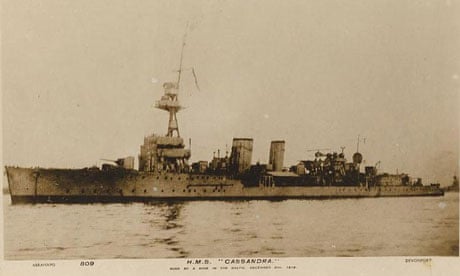The wrecks of three British warships sent to forestall a Soviet and German takeover of the Baltic states after 1917's October revolution have been found off the coast of Estonia.
Sonar searches by an Estonian minesweeper have located the remains of the cruiser HMS Cassandra and two Flower Class sloops, HMS Myrtle and HMS Gentian, in deep water near the island of Saaremaa.
The operation completes a jigsaw started by divers who found parts of the Myrtle in 1937 and a later team which attached a memorial plaque to the ship's sheared-off stern 10 years ago. It is also a belated tribute to the accuracy of Royal Navy navigation in 1919, when the two smaller ships sank after hitting mines.
The chief of staff of Estonian naval forces, Commander Ivo Värk, said the co-ordinates of the site made during the rescue of the Gentian and Myrtle's crews were surprisingly accurate, considering methods at the time. The measurements were taken by the commander of the British anti-Bolshevik squadron of 22 ships, Admiral Sir Edwyn Sinclair Alexander-Sinclair.
A hero of the epic Battle of Jutland in the first world war, when his light cruiser fired the first shots after signalling an enemy in sight, the admiral was given the honour in 1918 of leading the defeated German High Seas fleet into the Royal Navy's base at Scapa Flow, in the Orkney Islands. He was sent to war again soon after, when the British government took the controversial decision to intervene in the Baltic.
The Cassandra was sunk by an uncharted German mine early in the campaign, in December, with the loss of 11 of her 400-strong crew. The Myrtle and Gentian hits mines the following July, on the same day, with the loss of nine men, while clearing a passage to supply the fledgling independent Estonian government with rifles and field guns.
"We can be sure that these are the British ships that went down during the war of independence," said Värk, who authorised the use of new sonar equipment by the Estonian minesweeper Ugandi. The ship's captain, Lieutenant Commander Villu Klesmann, said less sophisticated equipment would have had problems sorting the remains from other seabed debris at the wrecks' depth of up to 100 metres.
"But we now have quite clear sonar images that give reason to believe these are the Cassandra, Gentian and Myrtle," he told Estonia's public broadcaster ERR. The Myrtle had the distinctive "op-art" dazzle camouflage of black, grey and white shapes, which broke up the ship's outline at sea.
The wrecks belong legally to the British government and are likely to be given official protection as war graves. The bodies of three crew of the Myrtle and Gentian are buried in the Estonian capital, Tallinn, but not all were recovered. One lieutenant, Henry Macdonald, was awarded the distinguished service cross after the tragedy for "displaying seamanship of the highest order".
The Estonians, who were fighting German as well as Soviet invaders to regain independence lost 700 years earlier, have always acknowledged the role of the squadron in their successful campaign. The fleet's supply of arms and blockade of the Soviet naval base of Kronstadt was one of the few relative successes in the Allied intervention against the Soviets, which petered out in a withdrawal from northern Russia and Siberia in 1920.
